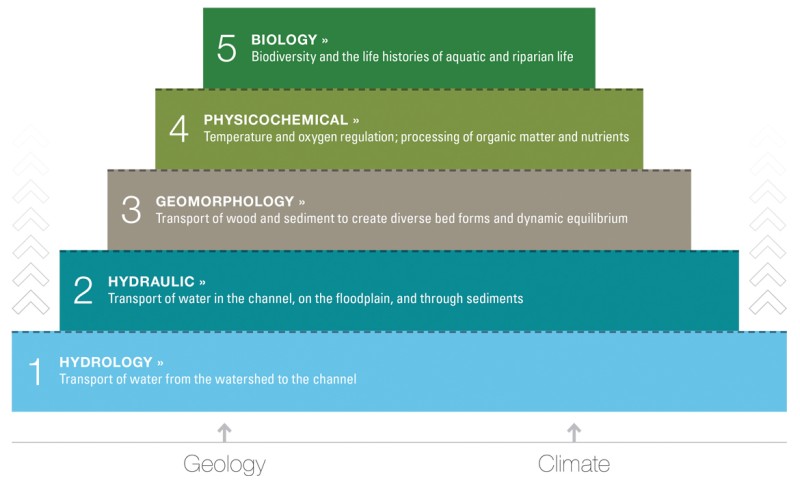Over the past several years, AsRA has been working in partnership with the U.S. Fish and Wildlife Service to restore the health of the rivers and streams in our watershed. Restoring stream health involves many different strategies, but the goals are always the same. From a scientific perspective, a "healthy" stream is more than a collection of subjective ideas that mean different things to different people. In 2012, a group of scientists specializing in the study and restoration of rivers and streams established a framework to help them understand and quantify the health of these critical natural systems. AsRA's approach to restoration is guided by this framework.
The Stream Functions Pyramid Framework is a tool for assessing and addressing deficiencies in the rivers on which communities depend for a range of services, from efficient drainage of stormwater to recreational opportunities such as kayaking and fishing. The pyramid is composed of five categories of stream functions. The base of the pyramid rests upon the foundation of geology and climate, the primary factors that determine the development of stable streams within a given region. As you move up the pyramid, each function is supported by the functional category beneath it.

The Stream Function Pyramid shows the hierarchy of functions that provide support for a biodiverse community of organisms that should be able to thrive in a healthy stream. Biodiversity is the highest level of function in a river ecosystem. (Image credit: StreamMechanics)
For example, populations of healthy, native fish and other aquatic organisms (biology) cannot thrive outside of the physical and chemical (physicochemical) parameters of water quality that make their survival and reproduction possible. Water quality issues cannot be addressed until we have stable channel forms and processes that transport wood and sediment (geomorphology), which depends on the efficient movement of water (hydraulics) downstream through the channel and its floodplain. And none of these efforts are worth addressing until we fully understand the processes and factors (e.g., runoff, baseflow, impervious surfaces, etc.) that affect the delivery of water to the channel (hydrology).
Support our river restoration work for clean water and healthy streams. Give with confidence today!
Recognizing that higher level functions like biology and water quality in rivers and streams depend on stable geomorphology and hydraulics helps us more effectively address the root causes of dysfunction. The framework is used to establish effective project goals that are tied to the appropriate level of function. If our goal is to restore habitat for native brook trout, then we must be aware of the lower-level functions that will allow for that restored habitat to remain functional. The framework is also an important part of the assessment process before restoration takes place. We can incorporate data from our assessments of biology, water quality, and geomorphology to determine the functional improvements that can be realized by implementing a restoration project. By looking at a variety of potential sites, we can prioritize our projects to make sure we are targeting the areas that will benefit the most from restoration work.
Once we understand the goals of stream restoration, we can establish metrics for measuring its success. A major concern in the field of stream restoration is the lack of monitoring after a project is completed. These projects are expensive to implement, and much of our time is often consumed looking for funding sources to survey, design, and construct projects in the many areas of the watershed known to have deficiencies with higher-level stream functions. AsRA is well-positioned to address this concern since we are not a consulting firm that moves from place to place, restoring sites and moving on. We live and work here with a long-term interest in restoring healthy streams, clean water, and biodiverse habitats.
In 2022, the Lake Champlain Basin Program (LCBP) awarded a grant to AsRA to fund the development and implementation of a monitoring protocol to assess the success of our restoration efforts. This critical funding will allow us to assess stream functions over a three-year period at several sites throughout the watershed. The project will help us formalize our post-restoration approach to monitoring by allowing us to evaluate and adopt relevant methods for geomorphic and biological assessment.

When the geomorphology of a stream is stable, as in this section of the East Branch Ausable River in the Town of Jay, improved water quality and increased biodiversity are often observed. By bringing geomorphic stability to impaired reaches, we can attempt to increase these functions and measure them through periodic monitoring.
Support from LCBP and our many donors is vital as we continue to develop and refine our approach to restoring and supporting healthy streams in the region. Our watershed is a complex landscape that reflects the balance between communities, infrastructure, recreation, and nature. We need effective tools to maintain that balance in ways that are long-lasting and self-sustaining. The Stream Function Pyramid Framework helps us develop better ways to protect and restore the health of streams in our watershed. Monitoring our efforts allows us to see which of our strategies are most effective. There is no cookie-cutter method to restoring and maintaining stream health. AsRA’s dedicated staff and continued presence in the watershed helps us continue to find the best practices for getting restoration right.
Story by Gary Henry, Stream Restoration Manager.
Sign-up for our e-newsletter to get weekly updates on the latest stories from the Ausable River Association.


